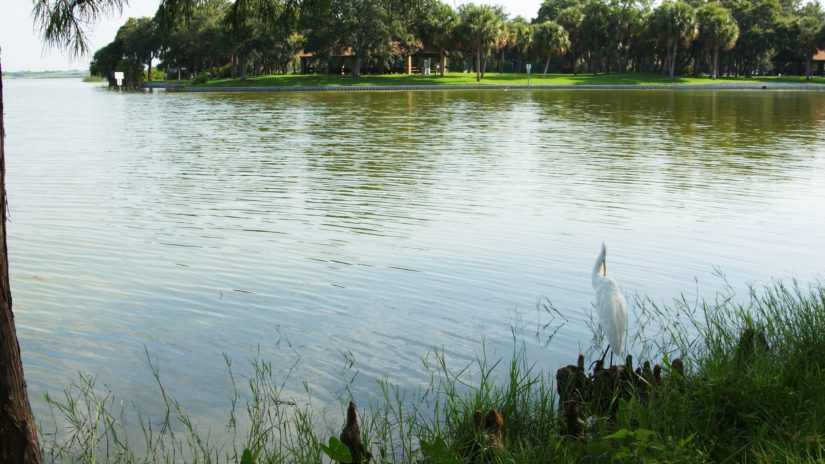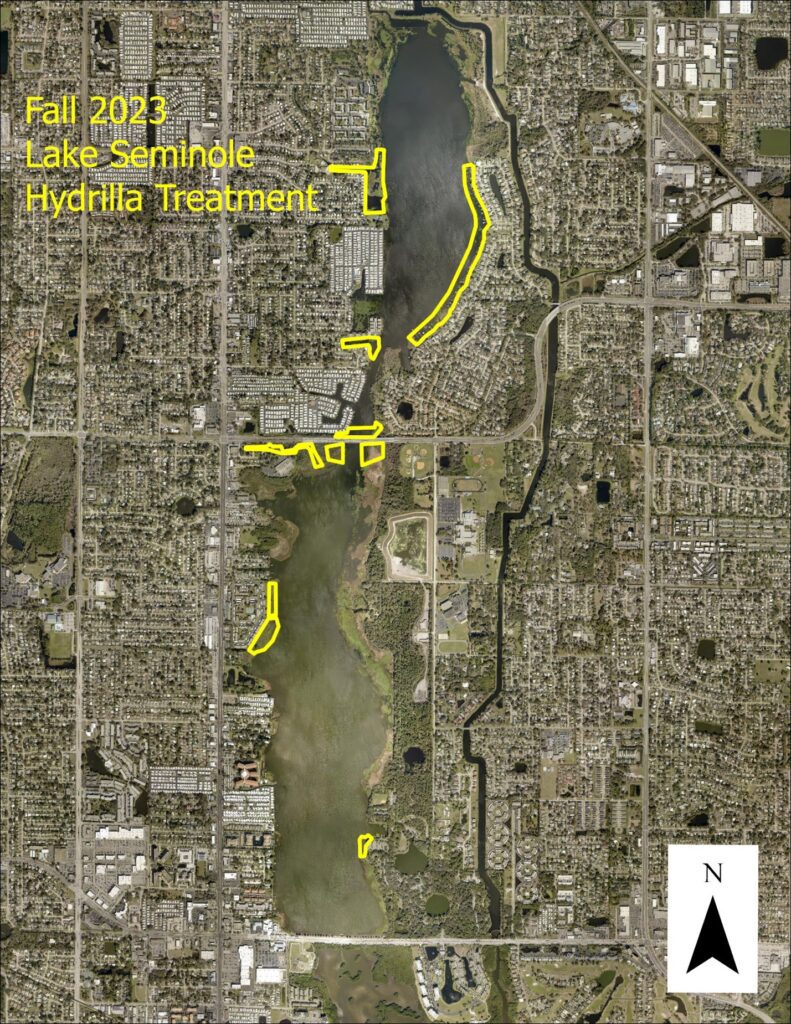Watershed Management – Lake Seminole Watershed

Lake Seminole is the second largest lake in Pinellas County at 684 acres. Its watershed encompasses 4,160 acres and includes multiple tributaries prior to flowing out of the lake through the weir at the south end and into the Long Bayou. The lake was created in the late 1940s by impounding a portion of Long Bayou during the creation of Park Blvd. It is a valuable recreational destination and is renowned for its largemouth bass and bluegill fishing.
Lake Seminole Aquatic Vegetation Management
Pinellas County Public Works is dedicated to the management of aquatic vegetation on Lake Seminole with the goal of enhancing habitat and promoting native aquatic plant growth. This is accomplished through cyclical lake-wide vegetation surveys and subsequent treatments by Pinellas County Vegetation Management. Pinellas County Vegetation Management provides treatments on Lake Seminole approximately every three weeks, depending on weather conditions. Aquatic plant management efforts by the county are only performed lake-wide for the treatment of Water Hyacinth, Water Lettuce and Hydrilla because of the invasive nature of these plants. Otherwise, we only perform vegetation management activities on county-owned areas of the lake.
The following are summaries of the current aquatic plant management efforts taking place on the lake. This section will be updated regularly.
Water Hyacinth Management (Updated 10/25/2023)
The presence of hyacinth has been detected at a few locations in the north and south lobes. The hyacinth consisted of small scattered patches and the patches were treated. Pinellas County Vegetation Management will continue lake-wide hyacinth inspections and conduct treatments as hyacinth reappears in the lake.
Water Lettuce Management (Updated 10/25/2023)
Water lettuce was observed in a few small patches in the south lobe in September. When found, the plants were treated with herbicide. Pinellas County staff continues to inspect for water lettuce and treat any found.
Hydrilla Management (Updated 10/25/2023)
Pinellas County Public Works continues to work with Florida Fish and Wildlife Conservation (FWC) staff on Hydrilla treatment options for the lake. To help combat Hydrilla growth in the lake, FWC released approximately 100 grass carp into the lake in early March 2022. In addition to the grass carp release, County staff plan several hydrilla treatments annually. Areas targeted for the fall 2023 treatment are seen in the map below. Treatments in the north and south lobe will start on October 31 and should be completed by November 2. Public Works will continue to monitor the lake and conduct treatments as needed.

The herbicide used in the treatment will be ProcellaCOR. It will be applied by County staff via submerged drag hose system from an airboat. This is the same herbicide used for the lake treatments conducted in 2021. After the lake-wide treatment has been completed, follow-up treatments on Hydrilla will continue on an as needed basis by Pinellas County Vegetation Management.
About Lake Seminole
Lake Seminole, the second largest lake in the county, has had poor water quality for many years. In 1991, Pinellas County and the Southwest Florida Water Management District (SWFWMD) partnered to complete the Lake Seminole Diagnostic Feasibility Study. This study showed that the primary cause of the lake’s worsening water quality was stable water levels as well as excess fertilizers entering the lake from untreated stormwater.
In 2001, the Lake Seminole Watershed Management Plan was completed. The plan built upon the diagnostic study by further evaluating the extent of the problem and developing recommendations to improve the lake’s overall health.
Several projects recommended in the diagnostic study and the watershed plan have been completed. These include:
- Construction of an adjustable water level control structure.
- Design and construction of a new retention pond.
- Refurbishment of an existing stormwater pond.
- Cattail harvesting.
- Two aquatic habitat restoration projects.
Watch the Restoring Lake Seminole video to learn more about the restoration efforts.
Current Boat Ramp Status: OPEN
As a reminder, all personal watercraft activities are to stay at least 100 feet away from all lake vegetation.